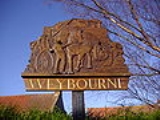
Weybourne
Encyclopedia
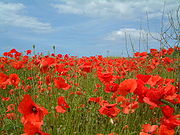
North Norfolk
North Norfolk is a local government district in Norfolk, United Kingdom. Its council is based in Cromer. The council headquarters can be found approximately out of the town of Cromer on the Holt Road.-History:...
(UK) and has the postcode prefix of NR25. The village straddles the A149
A149 road
The A149 is a major route in Norfolk, linking Kings Lynn to Great Yarmouth. It runs via the coast rather than on a more direct route such as the A47. The eastern section runs through The Broads.-Kings Lynn to Wells next the Sea:...
coast road and is three miles west of Sheringham
Sheringham
Sheringham is a seaside town in Norfolk, England, west of Cromer.The motto of the town, granted in 1953 to the Sheringham Urban District Council, is Mare Ditat Pinusque Decorat, Latin for "The sea enriches and the pine adorns"....
, within the Norfolk Coast AONB
Norfolk Coast AONB
The Norfolk Coast Area of Outstanding Natural Beauty covers over 450 km2 of coastal and agricultural land from the The Wash in the west through coastal marshes and cliffs to the sand dunes at Winterton in the east....
. Weybourne is mentioned in the Domesday book
Domesday Book
Domesday Book , now held at The National Archives, Kew, Richmond upon Thames in South West London, is the record of the great survey of much of England and parts of Wales completed in 1086...
and in that survey it is called Wabrume. There are remains of an old Augustinian priory
Priory
A priory is a house of men or women under religious vows that is headed by a prior or prioress. Priories may be houses of mendicant friars or religious sisters , or monasteries of monks or nuns .The Benedictines and their offshoots , the Premonstratensians, and the...
founded around 1200 AD on the site of a simpler Saxon church by Sir Ralph de Meyngaren (Mainwearing). By 1494 only a prior and three canons lived there. One canon complained that the priory was so poor it was unable to pay him his 20 shillings of annual pocket money. At another visitation
Canonical Visitation
A canonical visitation is the act of an ecclesiastical superior who in the discharge of his office visits persons or places with a view of maintaining faith and discipline, and of correcting abuses by the application of proper remedies.-Catholic usage:...
in 1514 there was only a prior and one canon and this remained until King Henry VIII
Henry VIII of England
Henry VIII was King of England from 21 April 1509 until his death. He was Lord, and later King, of Ireland, as well as continuing the nominal claim by the English monarchs to the Kingdom of France...
ordered the dissolution of monasteries
Dissolution of the Monasteries
The Dissolution of the Monasteries, sometimes referred to as the Suppression of the Monasteries, was the set of administrative and legal processes between 1536 and 1541 by which Henry VIII disbanded monasteries, priories, convents and friaries in England, Wales and Ireland; appropriated their...
and priories.
The village is surrounded by well-ordered arable fields, woodland and heathland. The area is excellent for walking, enjoying the countryside and coast. There are opportunities to see wildlife and bird-watching is very popular.
Changes in government policy have discontinued management of coastal erosion
Coastal erosion
Coastal erosion is the wearing away of land and the removal of beach or dune sediments by wave action, tidal currents, wave currents, or drainage...
in North Norfolk.
Amenities
.jpg)
Defence
Weybourne has long been considered a possible site for invasion, one reason being the deep water offshore. "He who would all England win, should at Weybourne Hope begin" During the Second World War defences were constructed around Weybourne as a part of British anti-invasion preparations of World War IIBritish anti-invasion preparations of World War II
British anti-invasion preparations of the Second World War entailed a large-scale division of military and civilian mobilisation in response to the threat of invasion by German armed forces in 1940 and 1941. The British army needed to recover from the defeat of the British Expeditionary Force in...
. The beaches were blocked by landmines and extensive scaffolding barriers
Admiralty scaffolding
Admiralty scaffolding, also known as Obstacle Z.1 or sometimes simply given as beach scaffolding or anti-tank scaffolding, was a British design of anti-tank and anti-boat obstacle made of tubular steel. It was widely deployed on beaches of southern England, eastern England and the south western...
; further inland there were pillboxes
British hardened field defences of World War II
British hardened field defences of World War II were small fortified structures constructed as a part of British anti-invasion preparations. They were popularly known as pillboxes by reference to their shape.-Design and development:...
, barbed wire entanglements, a long anti-tank ditch and other defences.
Weybourne Camp
During the Second World War, Weybourne Camp was a highly secret site and was an Anti-Aircraft Artillery range. This, along with a complementary camp at StiffkeyStiffkey
Stiffkey is a village and civil parish on the north coast of the English county of Norfolk. It is situated on the A149 coast road, some east of Wells-next-the-Sea, west of Blakeney, and north-west of the city of Norwich....
, represented the main live firing training ranges for ACK-ACK Command in World War II
World War II
World War II, or the Second World War , was a global conflict lasting from 1939 to 1945, involving most of the world's nations—including all of the great powers—eventually forming two opposing military alliances: the Allies and the Axis...
. Here the Norfolk coastline became a controlled zone by the British forces. This controlled zone extended 10 km deep into the North Sea
North Sea
In the southwest, beyond the Straits of Dover, the North Sea becomes the English Channel connecting to the Atlantic Ocean. In the east, it connects to the Baltic Sea via the Skagerrak and Kattegat, narrow straits that separate Denmark from Norway and Sweden respectively...
around Norfolk
Norfolk
Norfolk is a low-lying county in the East of England. It has borders with Lincolnshire to the west, Cambridgeshire to the west and southwest and Suffolk to the south. Its northern and eastern boundaries are the North Sea coast and to the north-west the county is bordered by The Wash. The county...
. Weybourne Camp was a vital part of this zone.
Weybourne Camp was visited twice by Winston Churchill
Winston Churchill
Sir Winston Leonard Spencer-Churchill, was a predominantly Conservative British politician and statesman known for his leadership of the United Kingdom during the Second World War. He is widely regarded as one of the greatest wartime leaders of the century and served as Prime Minister twice...
in 1941. These visits took place immediately after the Dunkirk evacuation when British defences were on high alert. During his first visit, a demonstration of projectile firing was carried out, but the result was most unsatisfactory. The Prime Minister gave the commandant just seven days to improve the standard. On the second visit, each demonstration repeatedly ended in failure until finally, a Queen Bee pilotless target aircraft was shot down and crashed close to the VIP enclosure. History has it that all the senior staff were replaced the following day.
The strange tale of the German spy ring at Weybourne windmill
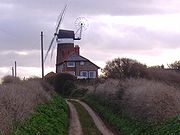
Weybourne Windmill
Weybourne Windmill is located on the eastern high ground above the village of Weybourne in the English county of Norfolk. It is on the northern side of the A149 coastal road that links King’s Lynn to Great Yarmouth. The Windmill is 3 miles west of Sheringham and is within the Norfolk Coast AONB...
that has been restored but not to its working condition. It was first built in 1850. Rumours surrounded the residents of the mill during the Second World War of spying for the Germans. Two local policeman were walking down the lane from the old coastguard cottages towards the mill at night when they both saw a light flashing from the top of the mill out towards the sea. Suspicions rose in the village about the man and his strange wife who lived at the mill.
The man living in the mill was a Mr Dodds and his wife apparently had a strong foreign accent which locals described as "like German
German language
German is a West Germanic language, related to and classified alongside English and Dutch. With an estimated 90 – 98 million native speakers, German is one of the world's major languages and is the most widely-spoken first language in the European Union....
or Austrian". Apparently nothing was done (which seems odd, given the wartime conditions and its closeness to Weybourne Camp), but seemingly it bothered one of the policemen and he went back out a couple of nights later and saw this again. The story goes that Mrs Dodds left her bicycle unattended outside the tennis court one day, and the bicycle fell over. A local picked the bicycle up and then the bag, which had fallen out of the basket. He took a look inside and found a radio transmitter. He told the police and a day or two later the authorities arrived and took the lady and her husband away.
Weybourne also had a watermill which can still be found on Beach Road.
The Muckleburgh Collection at Weybourne Camp
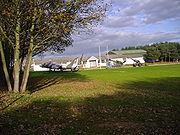
Muckleburgh Collection
The Muckleburgh Collection is a military museum sited on a former military camp at Weybourne, on the North Norfolk coast, England. It was opened to the public in 1988 and is the largest privately-owned military museum in the United Kingdom.-History:...
: the largest privately-owned collection of tanks, armoured cars and other military vehicles used in wars across the globe.
The North Norfolk Steam Railway
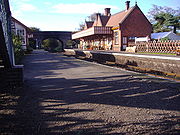

North Norfolk Railway
The North Norfolk Railway – also known as the "Poppy Line" – is a heritage steam railway in Norfolk, England, running between the coastal town of Sheringham and Holt, It cuts through the countryside to the east of Weybourne with views of its windmill and passes through the well preserved country...
which runs from Sheringham through Weybourne to Holt
Holt railway station (North Norfolk Railway)
Holt railway station is the current terminus of the North Norfolk Railway, and is a new-build station built on the site on the proposed, but never built, Blakeney branch junction....
. Also known as the "Poppy Line", this marvellously-preserved steam railway cuts through the countryside to the east of Weybourne and passes through the delightfully-preserved country station which also houses a locomotive shed together with a carriage maintenance and restoration centre. Weybourne railway station is about 1,000 yards from the village centre. The station is signposted from the coast road; the turning is just opposite the church. The main station was built in 1900 although other structures, of the appropriate era, such as the signal box, waiting room and footbridge have been 'imported' from other locations. (BR, on the closure of the line, raised the station and track, apart from the main station building). Its main claim to fame is as the location of the Dad's Army
Dad's Army
Dad's Army is a British sitcom about the Home Guard during the Second World War. It was written by Jimmy Perry and David Croft and broadcast on BBC television between 1968 and 1977. The series ran for 9 series and 80 episodes in total, plus a radio series, a feature film and a stage show...
episode, The Royal Train
The Royal Train
The Royal Train is the third episode of the sixth series of the British comedy series Dad's Army that was originally transmitted on the 14 November 1973....
, although it is frequently used by other film-makers and artists. On the station there is a small shop and buffet selling sandwiches, soft drinks, coffee etc. Visitors can enjoy a cup of tea from the buffet and take advantage of the picnic area to watch the trains come and go. At weekends there is a bookshop selling a wide range of old railway books and magazines, together with railway videos and some CDs commemorating times past. The railway offers a 10.5 mile round trip by steam train (vintage diesel trains on some journeys) through a delightful area of North Norfolk
North Norfolk
North Norfolk is a local government district in Norfolk, United Kingdom. Its council is based in Cromer. The council headquarters can be found approximately out of the town of Cromer on the Holt Road.-History:...
designated as being of outstanding natural beauty.
The Coastline and Smuggling
At Weybourne the coast has an unusually steep shingle beach which was regarded as a vulnerable spot during the threat of the Spanish ArmadaSpanish Armada
This article refers to the Battle of Gravelines, for the modern navy of Spain, see Spanish NavyThe Spanish Armada was the Spanish fleet that sailed against England under the command of the Duke of Medina Sidonia in 1588, with the intention of overthrowing Elizabeth I of England to stop English...
in 1588. The village was also a well-used location for smuggling items such as over-proof gin and pressed bales of tobacco. The coast between Sheringham and Weybourne was popular for landing goods because ships could anchor closer to the shore than anywhere else in the area. There was also a convenient gap in the cliffs through which goods could be easily transported. Local folklore says that the miller at the local windmill would stop the mill's sails in the form of a cross to warn the smugglers that the customs or coastguards were on to them; however if the coast was clear he would set the sails going once more. On Weybourne beach there was so little cover for the waiting land party that the men were reputed to bury themselves neck-deep in the shingle
Shingle beach
A shingle beach is a beach which is armoured with pebbles or small- to medium-sized cobbles. Typically, the stone composition may grade from characteristic sizes ranging from two to 200 mm diameter....
until the smuggling
Smuggling
Smuggling is the clandestine transportation of goods or persons, such as out of a building, into a prison, or across an international border, in violation of applicable laws or other regulations.There are various motivations to smuggle...
vessel appeared on the horizon
Horizon
The horizon is the apparent line that separates earth from sky, the line that divides all visible directions into two categories: those that intersect the Earth's surface, and those that do not. At many locations, the true horizon is obscured by trees, buildings, mountains, etc., and the resulting...
. This story perhaps stretches the credulity to the limits, but the fact that it is also told of Suffolk locations adds at least a little weight. In the 1800s, William J. Bolding, the owner of Weybourne water mill
Spring Beck (Norfolk)
Spring Beck is a minor watercourse in the north of the County of NorfolkThis small short Beck rises in a substantial hollow on the edge of Hundred Acre Wood in an area called Weybourne Pits close to Weybourne railway station. From its spring it flows under the track bed of the North Norfolk Railway...
and much of the inland areas at Weybourne, reputedly turned a blind eye to goods landed on the beaches bordering his property, and was rewarded with contraband left discreetly on his doorstep. In February 1837, a Lieutenant George Howes, and his men from Weybourne, intercepted a large gang of armed smugglers at nearby Kelling
Kelling
Kelling is a village and a civil parish in the English county of Norfolk. The village is west of Cromer, north of Norwich and north-east of London. The village straddles the A149 Coast road between Kings Lynn and Great Yarmouth...
. Many shots were exchanged and the coastguard men recovered five horses with carts which carried 540 gallons of Brandy
Brandy
Brandy is a spirit produced by distilling wine. Brandy generally contains 35%–60% alcohol by volume and is typically taken as an after-dinner drink...
and around 4,000 pounds of manufactured tobacco
Tobacco
Tobacco is an agricultural product processed from the leaves of plants in the genus Nicotiana. It can be consumed, used as a pesticide and, in the form of nicotine tartrate, used in some medicines...
.
Volunteers manned the Rocket House and saved many lives from the ships wrecked along the Weybourne coast. The crew of the coal ship Emily however were not so lucky when it was lost. They all lost their lives except for the master who survived. In 1823 a brig from Naples
Naples
Naples is a city in Southern Italy, situated on the country's west coast by the Gulf of Naples. Lying between two notable volcanic regions, Mount Vesuvius and the Phlegraean Fields, it is the capital of the region of Campania and of the province of Naples...
, Italy
Italy
Italy , officially the Italian Republic languages]] under the European Charter for Regional or Minority Languages. In each of these, Italy's official name is as follows:;;;;;;;;), is a unitary parliamentary republic in South-Central Europe. To the north it borders France, Switzerland, Austria and...
, carrying a cargo of olive oil
Olive oil
Olive oil is an oil obtained from the olive , a traditional tree crop of the Mediterranean Basin. It is commonly used in cooking, cosmetics, pharmaceuticals, and soaps and as a fuel for traditional oil lamps...
broke up, but six of her crew were saved. When the Norwegian barque, called Ida was wrecked, carrying pit-props to Cardiff, all the crew was rescued using a rocket line. The crew and some villagers salvaged some of the pit-props and it is said that many of these timbers survive in the barns and cottages around Weybourne to this day. In January 1915 the bodies of six sailors from the S.S. George Royal were washed up on Weybourne beach. There is a tombstone in the churchyard sacred to their memory. The Rocket House mentioned earlier still stands but is now a private residence.
Notable people
- The Rt Hon. Sir John MajorJohn MajorSir John Major, is a British Conservative politician, who served as Prime Minister of the United Kingdom and Leader of the Conservative Party from 1990–1997...
, KG, CH, Prime MinisterPrime ministerA prime minister is the most senior minister of cabinet in the executive branch of government in a parliamentary system. In many systems, the prime minister selects and may dismiss other members of the cabinet, and allocates posts to members within the government. In most systems, the prime...
of the United Kingdom from 1990 to 1997, owns a holiday home in Weybourne.
See also
- Spring BeckSpring Beck (Norfolk)Spring Beck is a minor watercourse in the north of the County of NorfolkThis small short Beck rises in a substantial hollow on the edge of Hundred Acre Wood in an area called Weybourne Pits close to Weybourne railway station. From its spring it flows under the track bed of the North Norfolk Railway...
- North Norfolk RailwayNorth Norfolk RailwayThe North Norfolk Railway – also known as the "Poppy Line" – is a heritage steam railway in Norfolk, England, running between the coastal town of Sheringham and Holt, It cuts through the countryside to the east of Weybourne with views of its windmill and passes through the well preserved country...
- Weybourne WindmillWeybourne WindmillWeybourne Windmill is located on the eastern high ground above the village of Weybourne in the English county of Norfolk. It is on the northern side of the A149 coastal road that links King’s Lynn to Great Yarmouth. The Windmill is 3 miles west of Sheringham and is within the Norfolk Coast AONB...

